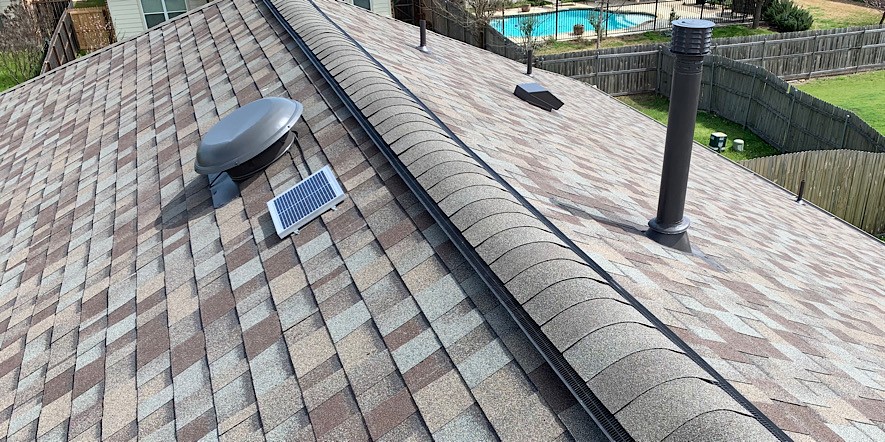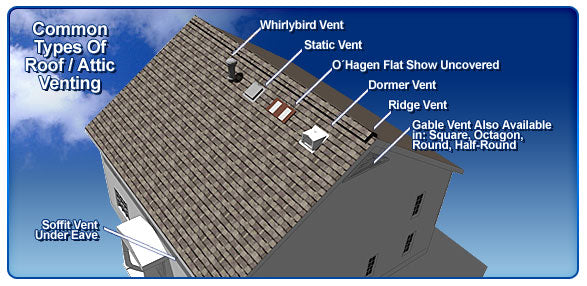Imagine standing on a sweltering summer day, feeling the heat seep into your home despite the air conditioner running full blast. It’s uncomfortable, right?
You’re not alone. Many homeowners face the same dilemma and often wonder about the best solution to keep their homes cool without burning a hole in their wallets. This is where roof ventilation comes into play. You might be asking yourself, “Should I choose a ridge vent or an attic fan?
” It’s a crucial decision that affects not only your comfort but also the energy efficiency and longevity of your home. We’ll dive into the differences between ridge vents and attic fans, helping you decide which option suits your needs best. Whether you’re trying to combat the heat or ensure proper ventilation for your attic, understanding these choices can make a significant impact. By the end, you’ll have a clear picture of which solution aligns with your home’s requirements, keeping you comfortable and your energy bills in check. So, let’s explore how these two popular ventilation options can transform your living space.

Credit: www.honestroof.com
Benefits Of Ridge Vents
Ridge vents offer continuous airflow along the roof peak, ensuring efficient temperature regulation. They work quietly without consuming energy, unlike attic fans. This passive system helps in reducing moisture buildup, preventing mold and extending roof life.
When considering how to improve your home’s ventilation, you might wonder about the benefits of ridge vents. These vents are installed at the peak of your roof and can offer several advantages over traditional attic fans. Understanding how ridge vents work can help you make an informed decision for your home.Natural Ventilation
Ridge vents utilize the natural flow of air to ventilate your attic. By allowing hot air to escape from the highest point of your roof, they create a continuous airflow. This passive system doesn’t rely on electricity, making it both efficient and eco-friendly. Have you ever noticed how stuffy attics can get during summer? Ridge vents help prevent this by consistently cycling fresh air through the attic. This reduces humidity and can protect your home from mold and mildew.Energy Efficiency
Ridge vents can help lower your energy bills. By reducing the temperature in your attic, they ease the burden on your air conditioning system. This means your AC doesn’t have to work as hard, which can lead to noticeable savings. Imagine a scenario where your attic acts like a heat trap, driving your cooling costs through the roof. With ridge vents, you can mitigate this problem, creating a more comfortable and cost-effective environment inside your home.Aesthetic Appeal
Ridge vents blend seamlessly with your roofline, maintaining your home’s visual harmony. Unlike bulky attic fans, they don’t protrude or draw attention. If preserving your home’s curb appeal is important, ridge vents are a great choice. Have you ever driven past a home with unsightly roof installations and thought it could look better? Ridge vents avoid this pitfall, allowing your home’s design to shine without interruption. Choosing ridge vents can be a smart move for your home. They offer natural ventilation, improved energy efficiency, and an appealing look. Have you considered how they might improve your living space?Advantages Of Attic Fans
Attic fans effectively boost ventilation, reducing heat and moisture in your attic space. They offer better air circulation than ridge vents, helping maintain a cooler home environment. These fans are an energy-efficient option, potentially lowering cooling costs during hot months.
Attic fans offer significant advantages for homeowners. They help maintain a cooler, more comfortable home environment. By improving airflow and reducing heat, attic fans can enhance energy efficiency. Let’s explore these benefits in detail.Enhanced Airflow
Attic fans significantly enhance airflow. They circulate air, pushing out hot, stagnant air. Fresh air enters, creating a healthier environment. Improved airflow can also extend the life of your roof. Proper ventilation prevents moisture buildup, which can damage roofing materials. This airflow ensures a balanced atmosphere in your attic.Temperature Control
Attic fans assist in controlling indoor temperatures. They expel hot air from the attic, helping to lower overall home temperatures. Cooler attics mean less heat seeping into living spaces. This can reduce the need for air conditioning. Lower energy bills result from less reliance on cooling systems. Attic fans offer an eco-friendly way to manage home temperatures.Humidity Reduction
Humidity can lead to mold and mildew in attics. Attic fans effectively reduce humidity levels. They remove excess moisture, keeping the attic dry. A dry attic protects insulation and wood structures from damage. Reduced humidity also means healthier air quality. This is particularly beneficial for allergy sufferers. Keeping humidity in check prevents costly repairs and health issues.Installation Considerations
Choosing between ridge vents and attic fans involves different installation considerations. Ridge vents require continuous installation along the roof peak for even airflow. Attic fans need proper wiring and placement to ensure effective ventilation. Each option has its own impact on your home’s energy efficiency.
When you’re deciding between a ridge vent and an attic fan, understanding the installation considerations can make a significant difference. Each option comes with its unique set of challenges and benefits. As you weigh your choices, think about how each will fit into your budget, installation process, and long-term maintenance needs.Cost Factors
The cost of installing a ridge vent can be lower than an attic fan. Ridge vents are often part of your roof’s structure and might be included when you replace your roof. Attic fans, on the other hand, require purchasing the fan itself and potentially hiring an electrician for wiring. Think about your current budget and future savings. An attic fan may have a higher upfront cost but could reduce cooling bills. Would an initial expense be worth the long-term savings for you?Complexity Of Installation
Ridge vents are relatively straightforward to install if you’re re-roofing. They integrate into the roofline and don’t require electrical work. If you’re handy, you might even consider doing it yourself. Attic fans, however, can be more complex. They often need wiring and secure placement in your attic space. Consider if you’re comfortable with electrical work or if hiring a professional is the better option.Maintenance Requirements
Ridge vents are low-maintenance. Once installed, they generally require little attention. Occasionally, you might need to check for blockages, especially after a storm. Attic fans need more regular checks. They have moving parts, meaning there’s a chance for wear and tear. You’ll need to ensure they’re functioning correctly to prevent overheating in the attic. Have you thought about how much time you’re willing to dedicate to maintenance? A ridge vent could offer you peace of mind with its simplicity. But if you’re open to more upkeep, an attic fan might offer the precise control you desire.
Credit: www.wholehousefan.com
Comparative Performance
Choosing between a ridge vent and an attic fan impacts attic ventilation. Both options offer unique benefits. Understanding their comparative performance helps in making an informed choice. This section explores their effectiveness, energy impact, and durability.
Effectiveness In Different Climates
Ridge vents perform well in moderate climates. They allow natural airflow throughout the attic. This helps in maintaining a balanced temperature. Attic fans are more suited for hotter climates. They actively circulate air, reducing heat buildup. In colder areas, ridge vents prevent moisture accumulation. This protects against mold and mildew.
Impact On Energy Bills
Ridge vents have no operational costs. They rely on natural convection. Attic fans require electricity to function. This adds to monthly energy bills. Yet, attic fans can lower cooling costs in summer. The reduction in heat load benefits air conditioners. Ridge vents may not impact bills directly. Their passive design is energy-efficient.
Longevity And Durability
Ridge vents are durable with few moving parts. They have a long lifespan. Made from sturdy materials, they withstand harsh weather. Attic fans have mechanical components. They may need regular maintenance. Fans can wear out over time. Ridge vents often last longer with minimal upkeep.
Choosing The Right Option
Choosing between a ridge vent and an attic fan can be challenging. Each option offers unique benefits for your home’s ventilation. To make an informed decision, consider various factors. These include your home’s specific needs, expert advice, and budget constraints. Understanding these elements will guide you to the best choice for your home.
Assessing Home Needs
Every home has unique ventilation requirements. Consider your climate and home size. In warmer areas, attic fans might offer more cooling. Ridge vents provide consistent airflow, suitable for various climates. Evaluate your attic’s current ventilation system. This assessment helps determine the best fit.
Professional Advice
Consulting with a ventilation expert can be beneficial. Professionals offer insights into your home’s specific needs. They can evaluate your attic’s current setup. With their guidance, you can make an informed decision. They can also recommend the best installation practices.
Budget Constraints
Budget plays a crucial role in your decision. Ridge vents are typically less expensive to maintain. Installation costs can vary. Attic fans might be costlier upfront. Consider long-term savings from each option. Evaluate potential energy savings over time. Choose an option that fits your budget without compromising quality.

Credit: renovaroofing.com
Frequently Asked Questions
What Are Ridge Vents?
Ridge vents are long, narrow openings along the roof’s peak. They allow hot air to escape, improving attic ventilation.
How Do Attic Fans Work?
Attic fans pull hot air out of the attic. They help cool the space, reducing strain on air conditioning.
Which Is More Energy-efficient, Ridge Vents Or Attic Fans?
Ridge vents are passive and use no electricity. Attic fans need power, making ridge vents more energy-efficient.
Can You Use Ridge Vents And Attic Fans Together?
Yes, but it’s essential to ensure proper balance. They should not counteract each other’s airflow.
What Are The Installation Costs For Both?
Ridge vents are generally cheaper to install. Attic fans have higher costs due to electrical work.
Conclusion
Choosing between a ridge vent and an attic fan depends on your needs. Ridge vents offer constant airflow without energy costs. They work well in areas with mild climates. Attic fans excel in hot climates, providing direct cooling. They use electricity, which may raise energy bills.
Consider your climate, budget, and attic size. Each option has its benefits and drawbacks. Consult with a roofing expert for personalized advice. Proper attic ventilation ensures a comfortable home. It also extends roof life and saves energy. Make an informed choice for your home’s ventilation.





